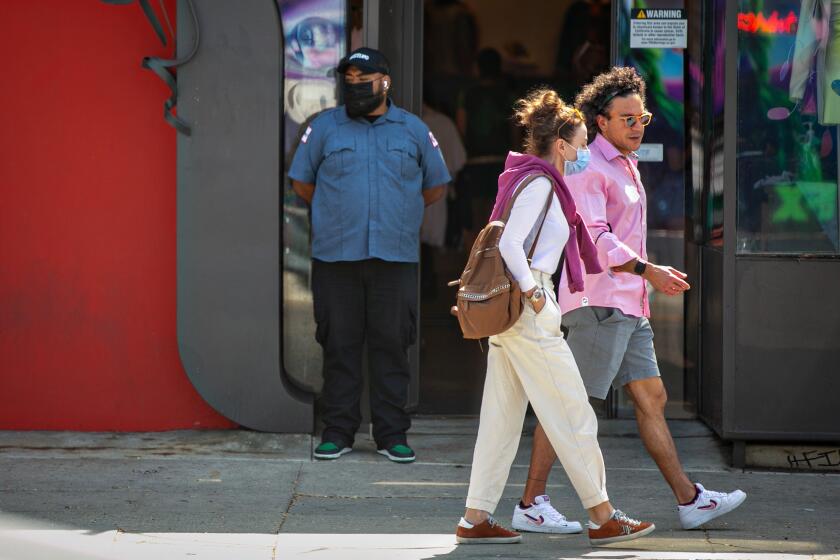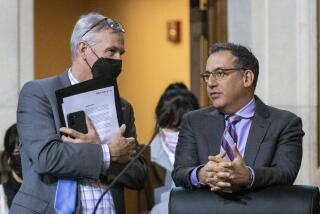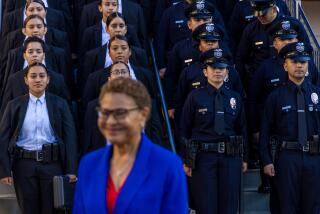As LAPD struggles to restore ranks, councilmembers pay extra for police coverage

- Share via
When crime began increasing in recent months along trendy Melrose Avenue, Los Angeles City Councilman Paul Koretz requested a larger police presence there — and tapped funding from his District 5 office to pay for it.
Koretz spent $30,000 on LAPD overtime in the Wilshire Division, where the Melrose corridor is located, as well as $30,000 in West L.A. and $10,000 each in West Valley and Pacific divisions, records show. When robberies continued along Melrose, he spent another $20,000 there.
“Once we had the issue of a lot of folks coming to Melrose to do crime, we said, ‘We have to hit this with everything we have,’ so we put in some extra funding,” Koretz said. “They gave us foot patrols and bike patrols and undercover folks and horse patrols.”
Across town, Councilman Joe Buscaino directed nearly $1.3 million in District 15 funds toward police overtime to address crime increases there — including $500,000 for foot patrols in San Pedro and more than $785,000 for such patrols in Wilmington, where a 12-year-old boy was recently killed in a triple shooting that also left a woman and a young girl injured.
Buscaino, a mayoral candidate and former police officer, said he saw the spending as restoring funds that belonged to the LAPD in the first place, before his colleagues “irresponsibly cut” the department’s budget by $150 million in the wake of the George Floyd protests last year and redistributed some of it into discretionary funds for individual councilmembers to spend on alternative public safety projects.
A string of armed robberies in a popular shopping district highlights a rise this year in the number of robberies involving guns.
“I opposed the City Council’s reactionary, feel-good cut to LAPD’s budget and warned my colleagues of the inevitable consequences. Sixteen months later, homicides are up 50% including the tragic murder of a 12-year-old Wilmington resident in my district last week,” Buscaino said in a statement to The Times on the spending. “Because public safety is the core responsibility of local government, I stand by my decision to allocate funds that were irresponsibly cut from LAPD, back to the department so they can respond to rising crime in my district.”
Since the start of this fiscal year, when the LAPD was allocated a budget of its own of $1.76 billion, councilmembers have tapped into their own council funds to pay for more than $1.5 million in extra LAPD overtime, according to a tally of such spending provided by the LAPD.
Some, but not all, of that spending was drawn from the discretionary funding established after the cut to the LAPD budget last year.
The spending is the latest wrinkle in an already complex story of police spending in L.A. since last year, when the city suffered massive revenue deficits related to COVID-19 and associated health measures, and saw activists and others flood the streets with demands that the LAPD be defunded in favor of alternative social service programs for the poor, ill, homeless and addicted.
It also highlights growing frustration with crime, the department’s response to it and the pace at which the LAPD has been able to rebound from a hiring freeze that helped shrink its ranks from more than 10,000 officers before the pandemic to fewer than 9,500 earlier this year.
At the end of last month, the department stood at just over 9,500 sworn officers.
The council authorized the LAPD to hire a force that is more than 9,700 strong this year, but it has not been able to reach that mark due to attrition and problems in recruitment — exacerbated by a bottleneck in the Personnel Department, which has not been able to conduct background checks fast enough to fill incoming recruit classes with as many officers as the department needs to expand its force, officials said.
During a meeting of the Police Commission last week, LAPD Chief Michel Moore told commissioners that he recently lent the Personnel Department an additional 10 sworn LAPD officers — bringing the total to 34 on loan — to further assist in conducting background checks. Moore said the commitment means less of a police presence in the streets in the short term but was necessary to push against shortfalls in the months to come.
“It’s a critical investment,” Moore said.
During the fiscal year ending June 30, LAPD officers worked more than 680,000 overtime hours for which they have not been paid. The city now owes $47.3 million.
Bruce Whidden, a spokesman for the Personnel Department, said the LAPD’s hiring needs spiked just as budget constraints associated with the pandemic reduced the number of background investigators working in the Personnel Department.
“LAPD is seeking to hire nearly 750 officers this fiscal year, nearly 50% more than the annual average during the four years preceding the COVID pandemic,” Whidden said.
He said the agency is now working to hire more background investigators to meet the new demand.
Alex Comisar, a spokesman for Mayor Eric Garcetti, said that keeping residents safe is Garcetti’s “top priority” and that he “is focused on making sure the LAPD has the resources it needs to do that” — including by authorizing additional overtime for patrols.
Several councilmembers said ensuring the LAPD has the resources to staff patrol and increase its presence in neighborhoods beset by violence is critical if the city is to turn a corner on violent crime — which has increased in the last two years, particularly in the number of homicides and shootings.
Councilman Paul Krekorian said when the council authorized a force of about 9,700 sworn officers this year, it wasn’t a recommendation but a directive — and one the police and personnel departments have failed to meet.
“When we authorize positions in the budget, I expect those positions to be filled. It’s not a suggestion, it’s a decision being made by the council and the mayor that those positions need to be filled,” Krekorian said. “Whatever the problems are in getting them filled need to be addressed.”
Since July, Krekorian has spent nearly $150,000 of District 2 funding on LAPD overtime shifts, including $120,000 to confront gangs and violence around the Whittsett Soccer Complex and other North Hollywood parks. He spent another $28,000 on fireworks suppression details.
Councilman Bob Blumenfield, of District 3, and Councilwoman Nithya Raman, of District 4, each spent about $22,500 on fireworks suppression, as well, records show.
Krekorian said the funding in North Hollywood is offsetting costs that the LAPD was incurring to ramp up its community-based policing approach around the parks, which requires officers to get to know community leaders, attend weekend events and log additional hours outside their normal shifts.
The Los Angeles Police Commission approved a proposed $213-million budget increase for the LAPD next year. The spending plan is a 12% increase over this year.
He said the spending is “entirely consistent” with the idea that public safety needs to be reimagined to include more community-based approaches.
Activists in L.A. who want the LAPD to be defunded have said any approach that results in money going to the LAPD is bound to fail and that city officials who talk about reimagining public safety only to revert back to funding the LAPD at historic levels are being disingenuous.
The LAPD recently called for a $213-million increase to its budget this coming fiscal year. Activists have said the department’s budget should instead be dramatically slashed.
Koretz said police play an important role in crime suppression and must remain a key piece of the crime fight moving forward — as indicated by recent outcomes along the Melrose corridor, where he said crime is down substantially since the overtime patrols began.
“This has really become a national story,” he said of recent crime, “and we’ve done our best to make that national story that we’ve responded and we have crime under control and Melrose is a safe place to be again.”
More to Read
Sign up for Essential California
The most important California stories and recommendations in your inbox every morning.
You may occasionally receive promotional content from the Los Angeles Times.













